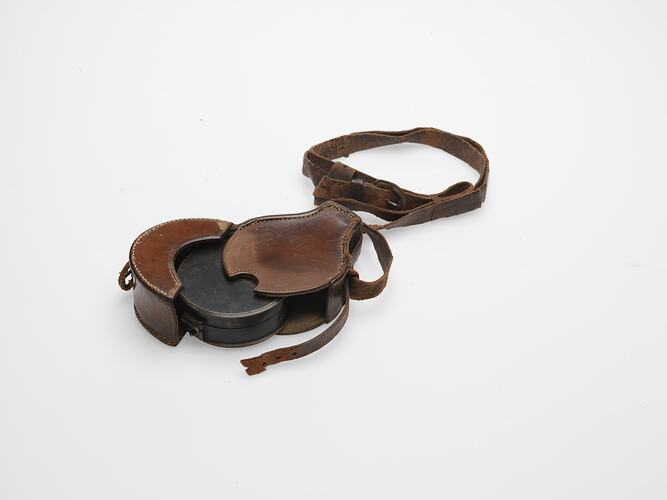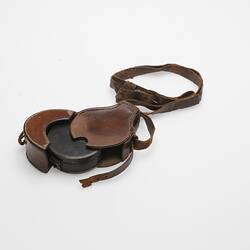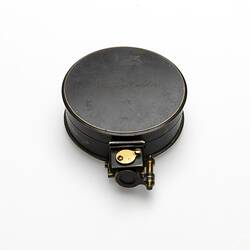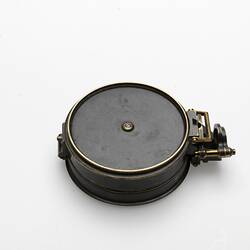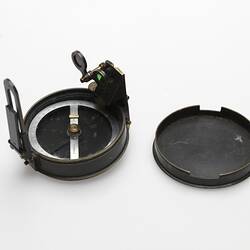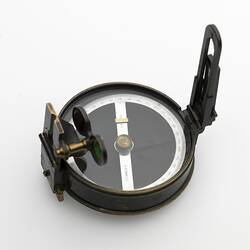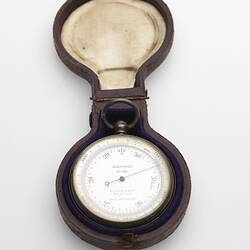Summary
Prismatic Type, Surveyor's Compass or Circumferenter (also spelt Circumferentor), made by W.F. Stanley & Co., London, England. With leather carrying case and shoulder strap.
This instrument was owned by William Calder, A.M.I.C.E., who was the founding chairman and chief engineer of the Country Roads Board of Victoria, from February 1913 until his death on 18 February 1928. Born in New Zealand in 1860, Calder had studied engineering at Otago University and gained accreditation as a surveyor in 1888, before emigrating to Victoria. In 1889, he was appointed as assistant town surveyor for the City of Footscray, becoming town engineer after gaining his Certificate of Municipal Engineering the following year. In 1897, he was appointed as city engineer and building surveyor to the City of Prahran, where he experimented with the use of a variety of road surfaces and kept meticulous records on their relative cost of construction and maintenance, which gained him an Australia-wide reputation as something of an expert in road surfacing.
It is believed that this instrument was used by Calder for fieldwork during his early years with the C.R.B., during which period he and his two fellow board members, W.T.B. McCormack and F.W. Fricke, personally toured every municipality in the State, meeting with councillors and municipal engineers to gain insights into local traffic and road conditions and to explain the functions and powers of the C.R.B.. Travelling by motor car, horse dray and horseback they covered thousands of miles surveying the key roads in each district with a view to determining which routes should be declared 'Main Roads' under the authority of the Board, and deciding which sections were most in need of upgrade or urgent repair. Although these surveys were preliminary in nature, a pocket instrument such as this would have been invaluable for gaining a quick indication of the alignment or compass bearing of each section of road and for recording such information in their field notebooks.
This instrument could be used to accurately measure the alignment of a road section or to take a bearing of a distant landmark. The prismatic eyepiece enables the user to simultaneously sight distant objects and the compass ring, with the scale appearing superimposed against the slight line fixed to the centre of the folding bracket on the opposite side of the instrument. Two small discs of red and green glass attached to the prism can be flipped down over the sight line to reduce glare. While less accurate than a tripod-mounted theodolite, a surveyor's compass was much faster and easier to use being capable in expert hands of producing readings accurate to ± 15 arc minutes (± 0.25 degrees) with ½ degree scale graduations when hand-held.
The surveyor's compass evolved as a specialised type of 'bearing compass' in the early 17th century and was commonly in use for surveying large-scale civil engineering works such as canals, roads and water supply by the early 18th century. The railway construction boom of the 19th century further expanded its use and helped stimulate numerous design improvements, including improved portability with smaller and lighter instruments that could be carried and operated in one hand. The first prismatic surveyor's compass design was patented in 1885, incorporating a viewing prism and lens attachment that enabled the user to more accurately sight the heading of geographical landmarks or an alignment when laying out the route of roads, railways, canals or aqueducts.
Physical Description
Circular instrument mounted in a brass case with glass window on top and loose brass cover engraved with the name "William Calder". The floating compass dial appears to be made of a light silver-coloured magnetic metal (probably a nickel and/or cobalt steel alloy) and has the form of a ring with a scale engraved around the perimeter and a cross-bar through the centre pivot. There is a brass knob attached over the centre pivot and a small brass clip on one arm of the cross-bar. The sighting-prism is mounted in a hinged brass bracket on one edge of the brass case. It has two flip-type filter glasses (red and green) and folds down into a retracted travelling position. On the opposite edge of the instrument is a hinged sighting bracket which when folded down across the top of the compass acts to lift the compass dial off the jewel tip of the pivot and lock it into a fixed travelling position. The instrument fits into a pear-shaped dark brown leather carrying pouch with an elongation at the bottom to fit the prism and circular form around the instrument body. The case has a crescent-shaped cover over the top with a leather fixing strap and buckle clasp. There is also a brown leather shoulder strap that slips through leather tabs around the perimeter of the case and has a nickel-plated metal buckle for adjusting the strap length. The strap has frayed and broken in two places having been knotted up as a crude repair.
More Information
-
Collecting Areas
-
Acquisition Information
Donation from Mr Stuart W. Calder, 11 Feb 2013
-
Manufacturer
Stanley, London, Middlesex, England, Great Britain, circa 1900
-
Past Owner
Mr William Calder M.Inst.C.E. - Country Roads Board of Victoria, by 1913 - 1928
-
Place Used
-
Inscriptions
Engraved "William Calder" in italic scrip in centre of brass lid. The compass dial is engraved 'STANLEY' 'LONDON' on the arms of the cross-bar and engraved with a scale in degrees from (0) to 360 around the perimeter, labelled every 10 degrees, with major divisions every 10 degrees, intermediate divisions every degree, and minor divisions every 0.5 degrees.
-
Brand Names
-
Classification
-
Category
-
Discipline
-
Type of item
-
Overall Dimensions
115 mm (Length), 90 mm (Width), 42 mm (Depth), 90 mm (Outside Diameter)
External dimensions of leather case, excluding strap, which measures approx 15 mm wide x 2 mm thick x 1200 mm long.
-
Other Dimensions
100 mm (Length), 75 mm (Width), 30 mm (Depth), 75 mm (Outside Diameter)
Dimensions of instrument only with prism and sighting bracket folded down and cover in place.
-
References
Compass, Wikipedia page, [Link 1] accessed 01/03/2013.
-
Keywords
Compasses, Circumferenters, Road Construction, Surveying, Surveying Instruments
